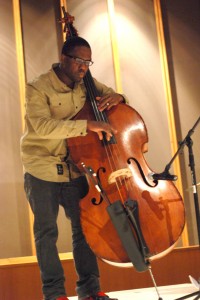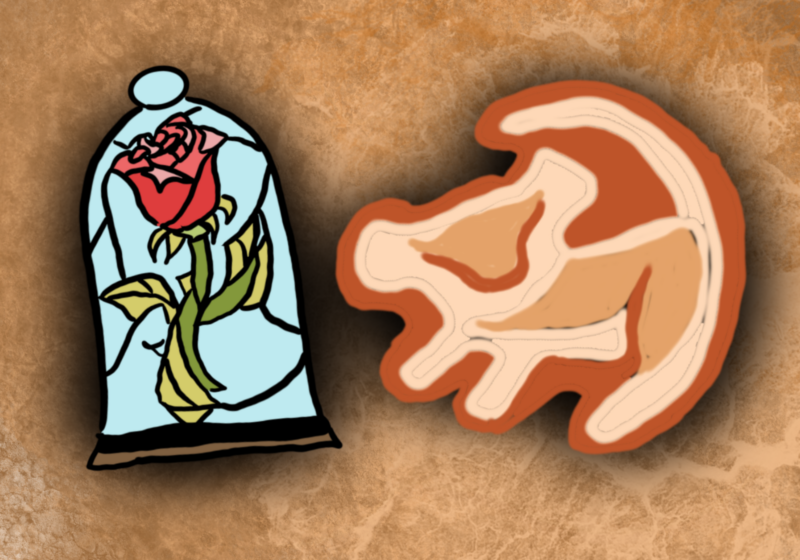
Bassist Derrick Hodge strums snazzy jazz in the Interfaith Chapel. Photo by Leah Fries, Staff Photographer
The Robert Glasper Trio’s performance at UR clearly wasn’t a terribly hyped-up event on campus. In fact, if you didn’t happen to glance at one of the fliers No Jackets Required put up or hear about it in passing, you probably didn’t even know the show was happening. However, if you weren’t among the 150 or so people in attendance, you missed one of the hottest jazz groups in the country, playing easily the best concert put on at UR in the two years I’ve been here.
Glasper returned to his church music roots in the Interfaith Chapel on Monday, March 21, along with bassist Derrick Hodge and drummer Mark Colenburg. The band also held a master class and an open discussion earlier that day. From the beginning of the show it was clear that, despite their growing reputation in the jazz community, the members of the Robert Glasper Trio don’t take themselves too seriously. Whether it was Glasper calling an NJR member up on stage to instruct him to dim the lights, joking with the audience or the band as a whole constantly smiling, nodding and grooving, it was evident that the group was having a damn good time, plain and simple.
Yet “plain and simple” couldn’t be further from descriptive of the group’s music. In fact, one of the trio’s greatest attributes is their ability to explore disparate musical extremes. The songs they played ranged from spacious and percussive to overwhelmingly full, complex and expressive. They incorporated elements of hip-hop and R&B, yet never strayed too far from their jazz roots. Each member plays incredibly complex, time-changing grooves and riffs, and yet it all becomes an integrated whole because each member is so great at making space for one another.
Twenty minutes after the scheduled start time, Glasper started off the show by treating the audience to his first piano solo. It began airy and spacious, with chords and runs coming in waves, then continually built and filled out until the rest of the trio made their entrance. The song went on to give both Hodgeman and Mark Colenburg a chance to show off their chops with a solo, but this was only an appetizer in terms of the skills that would be on display. The next number (which, as with all the song boundaries, was tough to discern because of the traditional improvisation taking place between each song) started off with a gorgeous bass solo by Hodgeman, which put not only his raw talent on display, but also his ability to design a complete melody on the spot. Near the end of the solo, Hodgeman started drumming on his strings with his left hand while still controlling the pitch, and this is where another critically important piece of the trio’s music fell into place: experimentalism.
Mark Colenburg then jumped in with a tripping backbeat, filled with non-conventional sticking and grooves. Glasper, the final piece of the puzzle, then reached into the piano and did something to restrict the hammer’s contact with the string, creating a unique sound somewhere between a guitar and a sitar. Throughout the song Glasper also infused some extra rhythm by tapping his piano pedals. The fact that the band experiments with the sounds of their instruments without compromising their actual sounds is one of the many factors that makes the trio completely one-of-a-kind.
If there were any heads not bobbing by this point, Mark Colenburg took care of that with another solo in the third song, which (like the song as a whole) featured dynamic contrast ranging from feathery bass drum hits to some of the concert’s most raucous moments. After a brief intermission, the group re-entrenched themselves in their roots by playing a classically-inspired tune based on traditional jazz scales, complete with a driving upbeat hi-hat and walking bass line.
The final number was well-chosen, as it was both the catchiest and the sexiest. Like the beginning of the show, it started with a wide-open Glasper solo that swelled and receded in waves. The solo went on to show off Glasper’s remarkable, lightning-fast hands, as well as introduce a haunting (and yet somehow uplifting) melodic motif — it was one of the concert’s most gorgeous moments. The song grew into the show’s fullest moment, then dropped out, making room for a wonderful callback to the melody from Glasper’s solo.
The performance ended by showcasing two of the band’s most outstanding elements — a great stage presence and a simple love of music. Before the final ritard, the trio stopped playing as Glasper sipped ihs Starbucks, nodded to someone in the crowd and waved to his family (Glasper is originally from Rochester), prompting the woman next to me — a clear jazz enthusiast — to lean over and say “a classic Miles Davis moment.” In the song’s closing moments, the trio started tapping on their instruments, creating a feel akin to a drum circle as each member played off one another light-heartedly. The last sound from the show? Glasper, Hodge and Mark Colenburg laughing at their impromptu ending. Rock may be dying, but the Robert Glasper Trio is making sure that the future of jazz at least is alive and well.
Fleming is a member of the class of 2013.




